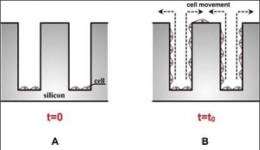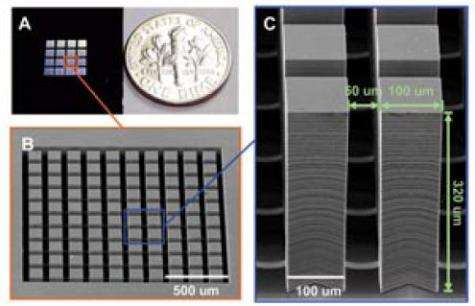April 29, 2011 feature
Race to the top: Decoding metastasis

(Medical Xpress) -- One of cancer's greatest and most insidious threats is metastasis – the three-dimensional migratory invasion of cancer cells from primary tumors to a distant part of the body. The challenge of defeating cancer lies not only in the fact that the area where the new colony appears is unpredictable, but also that different types of cancer metastasize at different rates and with varying degrees of growth. While standard therapeutic intervention modalities focus on destroying the cancer cells, a new generation of scientists – physicists, oncologists, molecular pharmacologists, materials scientists, computational biologists, and engineers working collaboratively – has taken a different tack: viewing cancer metastasis as intelligent, cooperative genetically-expressed adaptive behavior that can be decoded and, through emerging techniques in synthetic biology, reprogrammed.
Prof. Robert Austin, researcher in the Department of Physics at Princeton University, is leading such a group. In a pre-publication paper entitled Probing the invasiveness of prostate cancer cells in a 3D microfabricated landscape, Austin and his team describe their construction of a microfabricated chip with a three-dimensional topology consisting of lowlands and isolated square highlands, the latter standing hundreds of microns above the lowlands. The highlands – which Austin named Tepuis after Sir Arthur Conan Doyle’s science fiction work The Lost World – have enabled the team to successfully assess metastatic potential as cancer cells originating in the lowlands invade the highlands.
Cancer cell invasion behavior is clearly evident in three dimensional structures, he adds, referring to research conducted by John Wertz, researcher in Department of Ecology and Evolutionary Biology at Yale University. “While much research has been carried out in two-dimensional channels, the cellular behavior in three dimensions is remarkably different.”
As a test case, Austin’s team compared the Tepui-climbing behavior of two lines of prostate cancer cells: highly metastatic PC-3 bone marrow cancer cells with that of noninvasive LNCaP lymph node cancer cells. They observed that the prostate cancer cells never populated all available Tepui plateaus (only about 85%), and did so much more slowly that did the PC-3 cells. On the other hand, the more metastatic PC-3 cells quickly occupied all available Tepuis. Since the lymph node-derived line is known to exhibit a high degree of contact inhibition – the ability of cells to stop dividing when neighboring cells touch each other – Austin and his team ascribe this differential Tepui invasiveness to that factor.
“When a tumor undergoes metastasis,” Austin notes, “the cells form elongated spikes and invade other areas in a manner similar to neuronal dendritic growth, in that the cancer cells form neural dendrite-like tunnels. Moreover,” Austin continues, “rather than simple flow, cancer cells demonstrate motility and proliferation – directed motion with purpose, which implies a form of intelligence.” Austin metaphorically refers to highly metastatic cells as scouts, and the contact-inhibited cells as farmers or colonists that cooperate to first explore, and then colonize, a new site – behavior that he feels implies a “sense of survivability.”
Team will further explore this posited cooperative behavior in their next experiment, in which the two types will be mixed to test the hypothesis that the colonists will follow subsequently displace the high risk-taking scouts.
One of the most interesting aspects of Austin’s research is his computational perspective. He cites researcher Paul Davies, director of the BEYOND Center for Fundamental Concepts in Science at ASU and principal investigator of a major research program funded by the National Cancer Institute, who has commented that cancer cells appear to exploit an ancient “toolkit” to run programs encoded in their genome. If that’s the case – and given the morphological and behavioral similarity between cancer spikes and neuronal dendrites discussed above – Austin agrees it may be possible to identify in-common genetic sequences in the form of modular, subroutine-like genetic programs that express in various cell and tissue types. “If we learn to control that genetic expression, Austin concludes, “we can control cancer growth and metastasis.”

Other plans for future investigations involve adding collagen to the 3D chip to investigate the cells’ variable flow across a biomaterial surface. “The collagen matrix will change the cancer cells’ phenotype,” Austin predicts, “and a stronger phenotype differentiation should generate a more aggressive metastatic behavior.” Other cell lines and substances – including multiple myeloma cells in a 3D bone marrow matrix – will be also investigated to understand various replication environments.
Given Austin’s view of the incredible complexity of a computational biology-based approach to decoding the processes of life, as well as his refreshing penchant for science fiction, it is perhaps not surprising that he agrees with Arthur C. Clarke’s insightful Third Law(1) that “any sufficiently advanced technology is indistinguishable from magic.”
More information:
• Robert H. Austin Research Group at Princeton University austingroup.princeton.edu/
• Probing the invasiveness of prostate cancer cells in a 3D microfabricated landscape, PNAS Published online before print, April 7, 2011, doi: 10.1073/pnas.1102808108
• (1)Arthur C. Clark, Profiles of the Future (revised edition, 1973)
Copyright 2011 Medical Xpress / PhysOrg.com.
All rights reserved. This material may not be published, broadcast, rewritten or redistributed in whole or part without the express written permission of PhysOrg.com.














